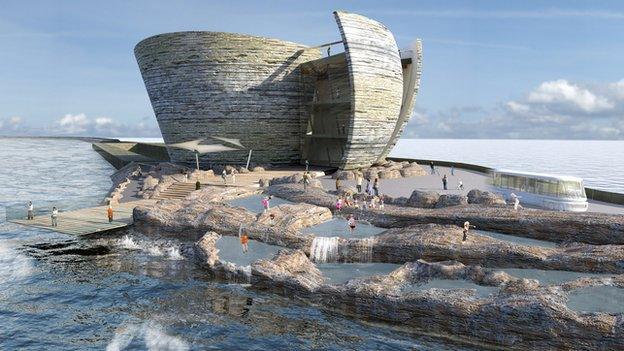Swansea Bay £850m tidal lagoon plan submitted
- Published
An artist's impression of how the lagoon around Swansea Bay could look if given the go-ahead
Plans have been submitted for a £850m tidal lagoon in Swansea Bay which could provide power for 120,000 homes for 120 years.
Tidal Lagoon Swansea Bay Ltd says it is the first step towards developing technology that could meet 10% of the UK's electricity needs from the tides.
The six-mile-long U-shaped seawall will go from Swansea docks to near Swansea University's new Fabian Way campus.
It would take two years to build and create 1,850 construction jobs.
There would also be 60 long-term operational jobs with up to another 90 linked to visitor spending and it is hoped it could be operating by 2018.
Mark Shorrock, chief executive of Tidal Lagoon Swansea Bay, said: "Until now, tidal energy has been heavily promoted by governments and environmentalists as an intuitive source of clean and reliable energy for our island nation, but the business response has focused on relatively small-scale tidal stream devices.
"The UK has the second highest tidal range in the world and today we are submitting an application for a development that will prove that this resource can be harnessed in a way that makes economic, environmental and social sense.
"Tidal lagoons offer renewable energy at nuclear scale and thus the investment of hundreds of millions of pounds in UK industries and coastal communities."
Environment correspondent Iolo ap Dafydd reports
He added: "Our intention is to supply 10% of the UK's domestic electricity by building at least five full-scale tidal lagoons in UK waters by 2023, before the UK sees any generation from new nuclear."
The lagoon would comprise an impounding "breakwater or seawall" capable of holding 11 square kms (4 sq miles) of water.
It would hold on to water and then let it out through turbines at both high and low tides which would generate electricity.
At low tide, water would flow from the lagoon into the sea, and from the sea into the lagoon at high tide.
Roger Falconer, professor of water engineering at Cardiff University, told BBC Radio Wales these were "exciting times" for Wales.
"This is the first one and this is what makes it exciting," he said.
"The big exciting opportunity as well is to take this concept of the Swansea Bay lagoon to north Wales, because along the north Wales coast we have considerable flooding, massive problems of flooding... and we either have to spend a fortune on defending, or we build lagoons along the north Wales coast."
He said lagoons would protect areas at risk from flooding, and said it would solve the problems currently facing the Somerset Levels.
"If you build a lagoon around Bridgewater Bay... that will solve the problems in the Somerset Levels.
"Then, when you have extreme conditions, the government could pay the electricity supplier to hold the water low in the lagoon and the water will all drain off in the Somerset Levels."
The project also includes the reintroduction of the native oyster to Swansea Bay, an oyster-shaped offshore visitor centre and national triathlon and water sports facilities.

The oyster-shaped visitor centre would be self-sufficient, according to the developer
It would be sited at the end of the lagoon's seawall with access by foot, cycle and electric bus.
The Planning Inspectorate will scrutinise the case initially, but because of its size - over 100 megawatts - the UK government's Energy Secretary Ed Davey has the final say as to whether it will go ahead.
According to the developer, research as part of the project's initial stages found that 86% of local residents were in favour of the scheme.
A report by Cardiff University in December - commissioned by the developer - said the lagoon would create over £5m annual local spend.
"As with the first kind of anything, you have a certain amount of scepticism - is this for real? is this really funded?" Mr Shorrock added.
"I think we've got people convinced it's for real, the power output is certain and therefore the funding is certain.
"Swansea is the proof of concept for the industry."
Not all convinced
Roger Falconer, professor of water engineering at Cardiff University, said the project brings 'exciting times'
South Wales West AM Peter Black said the lagoon "has the potential to bring a massive economic boost for Swansea and surrounding areas".
Friends of the Earth (FoE) Cymru and Wildfowl and Wetlands Trust have backed the plans.
Gareth Clubb, from FoE, said: "Provided they meet strict environmental criteria, tidal lagoons can play a key role in building a low carbon future, supplying clean electricity to many thousands of homes.
"With its huge coastline, the UK has plenty of potential for developing more schemes like this, along with other renewable forms of energy."
Sean Christian, from the RSPB added: "We welcome the fact that the conversation about energy projects in the Severn Estuary is now focused on tidal power lagoons, rather than a more damaging shore-to-shore barrage."
But Neath MP Peter Hain, who was a key supporter of the plans for a £25bn barrage in the Severn Estuary, is not convinced.
Hafren Power wanted to build an 11-mile barrage between Lavernock Point near Penarth, Vale of Glamorgan, and Brean near Weston-super-Mare, Somerset, but UK government ministers did not back it.
Mr Hain said: "The Swansea Bay lagoon is fine for Swansea Bay.
"It's 1,500 football pitches in size and you'd need 50 of them for the whole of the estuary to get anywhere near what the power of the barrage could do.
"That's why the barrage is the answer for the Severn Estuary."
- Published7 February 2014
- Published7 February 2014
- Published21 January 2014
- Published4 December 2013